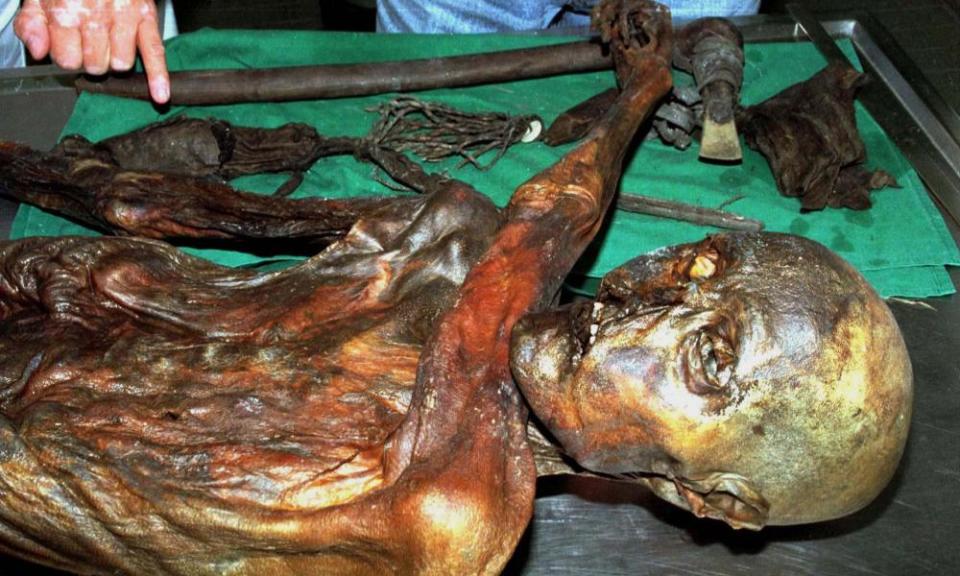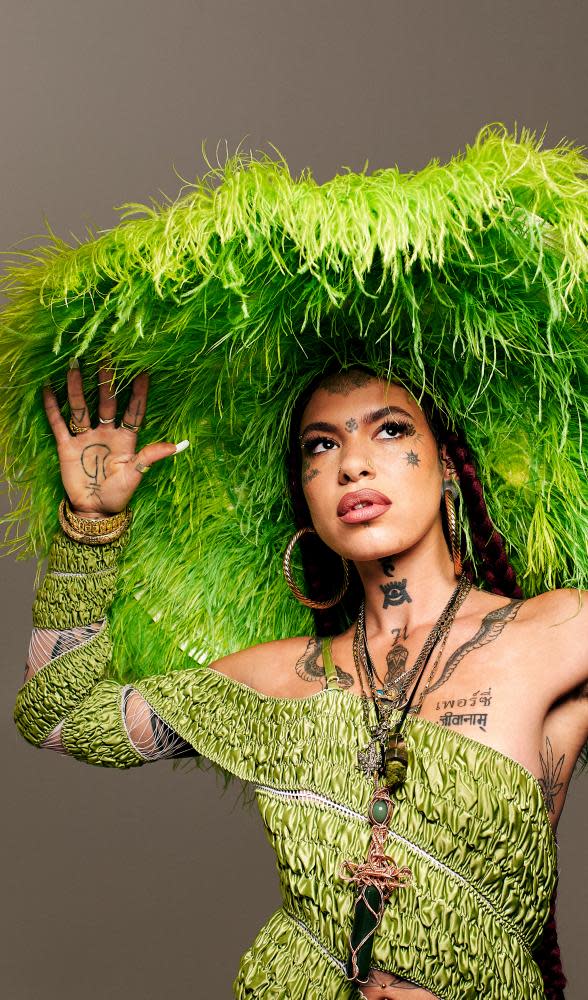Ink positive: how tattoos can heal the mind as well as adorn the body
If one thing has become obvious in the summer heat and the inevitable baring of flesh, it’s the degree to which body art is now the norm. At the pool, the park, or the pub beer garden, you’ll find an enormous variety of designs inked on the skin representing the breadth of human creativity.
About 20% of adults in the UK now have at least one tattoo, and that proportion is likely to grow. Cynics might argue that the increased uptake is a superficial fad, based purely on the aesthetic appeal of tattoos. In this view, they might be the result of a momentary impulse to follow a passing trend followed by years of regret, rather than something that holds deep meaning.
Prof Viren Swami, a psychologist at Anglia Ruskin University who studies body image, thinks that these superficial explanations are highly unlikely. “Given their permanence, and the pain that’s involved, and the planning that often goes into getting a tattoo, it’s very difficult to conceptualise tattooing as a fashion accessory,” he says.
In his opinion, it is far more interesting to examine the ways that people use body art for self-realisation, as artistic endeavours that are expressions of identity, body ownership, and personal growth. Many are now finding that tattoos are a particularly apt way of marking a bereavement – a means of holding the loved one close after death.
Like any art form, tattooing should be understood in its historical and cultural context. Our ancestors seem to have recognised the skin as a canvas since time immemorial. The oldest definitive proof of body art comes from Ötzi, the 5,300-year-old body of a man who remained frozen in a glacier near Bolzano, Italy, until it was discovered by two hikers in 1991. He bore 61 tattoos of geometric designs across his left wrist, lower legs, lower back, and his torso. Ancient body art – dating from at least 3,000 years ago – has also been found in human remains from Egypt, Russia, China and Chile.

Given how widespread tattooing is – and apparently always has been – some psychologists have suggested it may have an evolutionary purpose. According to one theory, you would have needed to have a robust immune system to survive the danger of infection after getting your skin inked; if you survived, it could show that you had good genes to pass on to your children. In this way, it acted as a fitness signal, making you more sexually attractive to prospective partners. Swami, however, is unconvinced by the theory. “I think it’s much easier to understand tattooing from a social and cultural perspective than it is from an evolutionary perspective,” he says. In other words, it is the way we use body art to express ourselves, within a particular context, that really matters.
The king with the dragon tattoo
The history of body art in Britain has been rather chequered. There are records of tattoos on indigenous Britons at time of Caesar’s invasion. Indeed, the practice was so widespread that the name Britain is likely to be derived from the Celtic word pretani, which may mean “tattooed folk” or “painted ones”.
Swami explains that tattoos gained renewed popularity after Captain Cook’s exploration of the Pacific, as sailors returned with designs inked by the people they encountered. “The twist in this tale, though, is that in the late 19th century, once the first electric tattooing machine had been invented, tattooing suddenly flipped and became very popular among the upper classes in England,” he adds. “And for the upper classes, it was much more about expressing their worldliness.” (King George V even had a tattoo of a red and blue dragon.) Over the 20th century, however, the art form lost some of its cachet, and tattooing came to be linked to aggression and rebellion, thanks, in part to its visibility in the punk movement and gang culture, before its current return to the mainstream.

It is tempting, Swami says, to link this movement to celebrities such as David Beckham or Angelina Jolie in the late 90s and early 00s, but he thinks the trend can tell us something more profound about our changing attitudes to the human body. Modern culture, he argues, has been very prescriptive about what we can do with our bodies – from societal attitudes to weight and fitness, to our expressions of gender or sexuality. Tattoos, he believes, have offered a way for people to exercise ownership and mark out their control over their flesh. “Tattooing can mean different things for different people,” he says. “But I think this idea of agency is really important – the ability to mark our bodies and say ‘This is meaningful to me’.”
Over the past decade, Swami has performed a series of studies comparing the personalities of people with and without tattoos. Overall, he did find some signs that seemed to confirm the older stereotypes; people with body art were slightly angrier and more impulsive than the average person with unmarked skin, but the differences were tiny. “In statistical terms, they are negligible,” he says. “Tattooed individuals today are essentially identical to people who have no tattoos.”
In one of his most intriguing studies, Swami examined people’s body image before and after they received their tattoos. He found that anxieties about their appearance, and general feelings of bodily dissatisfaction, immediately dropped after the participants’ skin had been inked. Importantly, the boost to their self-esteem was still evident in a follow-up three weeks later, suggesting that the effects were not simply a reflection of their excitement on the day itself – but may have represented a permanent change. “You can see the trajectory here,” Swami says. “Once you get your tattoo, you feel much closer to your body.”
Dr Joseph Pierre, a clinical professor in health care sciences at the University of California, Los Angeles, believes that the growing popularity of tattoos can also be traced to waning “puritanism” in the west. “Showing more skin in public – whether in terms of bare chests for men or sports bras in women – is increasingly accepted,” he says. “With that much more skin exposed, adorning the skin with tattoos is just another way of presenting to the world that which previously remained hidden.”
Like Swami, Pierre believes that the personal appeal of tattoos often goes far beyond their aesthetic value. (He describes them as “windows to the psyche”.) “Tattoos are often telling an important story through art that isn’t expressed in words,” he says. As a psychotherapist, he advises his colleagues to discuss body art as a way of opening up conversations “about other important issues or life events”.
Such assertions would seem to chime with the experiences of Mowgli, a tattoo artist and the owner of the Through My Third Eye studio in north London, who has attracted 150,000 Instagram followers with his intricate, futuristic creations.
He describes how each piece of art begins with an hour-long conversation with the client, in which they will discuss the ideas that they wish to represent. “When it comes down to your body, I think it’s the most sacred thing that you’ve got,” Mowgli says. For this reason, he wants the inspiration for the tattoo to come from an “authentic place” – something that is truly meaningful to the person. For many people, the tattoo will be a marker of particular life experience, he says – and the strength that they’ve derived from it. That includes bereavement and grief. (In some studios, you can even ask for someone’s ashes to be mixed with the ink.) But the focus, Mowgli argues, is usually positive rather than macabre. Those feelings may then be translated through designs inspired by mathematics or science – “things that are bigger than the material world”.
“Memorial tattoos are not about death,” agrees Prof Susan Cadell, a specialist in post-traumatic growth at the University of Waterloo in Ontario, who has interviewed many people about the use of tattoos in the grieving process. “They are really an expression of that bond and how that person influenced them.”
She describes one couple who had recently lost their son in a car crash. “They had given their son a hard time about him getting a tattoo, and pretty soon after he died, the father went to the same tattoo artist and got the same tattoo that his son had.” Both parents now have multiple tattoos that relate to their son – and five other members of the family have also chosen body art to remember their relative. Another interviewee chose a design of a tomato plant, to symbolise all the time they had spent gardening together; others have chosen to mark a loved one’s passing with a copy of his or her fingerprints – or a word written in the person’s handwriting.
The memorial tattoos are only one example of the ways that body art can promote growth after trauma. Swami is looking at how body art can help people to process the experience of domestic abuse. “It’s a way of reclaiming your body,” he says. A recent study from the University of Washington, meanwhile, charted the ways that “survivor tattoos” can aid the emotional recovery of people who are in remission from cancer. A growing number of people are even investing in “pandemic tattoos” as a way of marking their journey through the Covid-19 crisis and the (alleged) return to normal life.
Ultimately there may be almost as many reasons for getting body art as there are tattoos. Whether it’s a way of marking personal growth, celebrating parenthood, or sharing your personal identity through a meaningful quote, tattoos offer an indelible illustration of what is most important, on the most intimate of canvases. They could not be further from digital communication or social media – where memories can be written and deleted with ease. Body art demonstrates an investment that simply cannot be found in any other means of expression.
This increased desire for personal expression has led the studios themselves to become more creative, says Mowgli, as they strive to offer unique and inventive designs that will resonate with clients. As he puts it: “The art is the focus.”
While the stigma surrounding tattoos may be decreasing in the UK and US, Swami believes that it lingers in the workplace. “I know of organisations that still ask their employees to hide them,” he says. “And you have a whole market of makeup that’s designed to cover up tattoos.”
This is a shame, given the enormous range of reasons that people may have for their tattoos – and the stories that they can tell, the moments they can symbolise. It’s time to recognise the fact that the etchings on people’s bodies are often far from skin-deep.
David Robson is the author of The Intelligence Trap: Revolutionise Your Thinking and Make Wiser Decisions (Hodder & Stoughton, £9.99), which examines strategies to overcome biased reasoning. To support the Guardian and Observer order your copy at guardianbookshop.com. Delivery charges may apply

 Yahoo News
Yahoo News 
